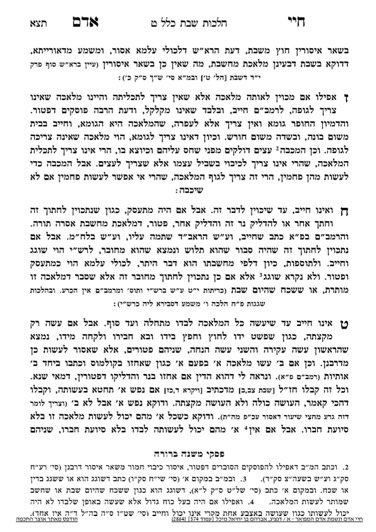We are continuing in siman 9, discussing the concept of performing a partial melacha. The Chayei Adam discusses a caveat given to us by Chazal. We mentioned that one of the ways to perform a partial melacha is to perform the melacha with someone else, such that both people are performing the melacha together. This is known as shnayim she’asu. However, the Chayei Adam clarifies that shnayim she’asu only applies when either party could have performed the melacha on their own. If the melacha could not have been performed by only one person, both parties are needed for the melacha to take place, so each takes full responsibility for the action, and both are chayav. It reverts back to being an issur mideoraysa.
If one could have performed the action on their own, but the other could not, Chazal do not look at it as both working together to complete the melacha. Rather, the one who could have performed the action on their own is considered to be performing the action completely on their own, and is chayav mideoraysa. The second person, who could not have performed the melacha on their own, is considered a mesayeia, assisting, and we pasken mesayeia ain bo mamish, the person assisting is not considered as performing anything meaningful. To be clear, it does not mean that mesayeia is muttar–it is assur miderabanan.
There is a scenario when mesayeia is muttar. If a woman forgot to cut her nails for the mikvah on Friday night, many rishonim and poskim allow for amira l’akum, to ask a non-Jew to cut her nails. The Mishnah Berurah writes that the woman should ask the non-Jew to cut her nails without a utensil, but rather by hand, in order to make the issur in question of cutting one’s nails an issur derabanan (due to the shinui), and thus creating a shvus d’shvus b’makom mitzvah. Many argue, and hold that cutting nails is always an issur derabanan, because it is a melacha she’eina tzricha legufah. If so, even if the non-Jew uses a utensil, it is still a shvus d’shvus b’makom mitzvah. Either way, if the Jewish woman is in any way turning her hand or otherwise assisting the non-Jew in the cutting of her nails, she is considered a mesayeia, but since we pasken mesayeia ain bo mamish, Chazal allow her to have her nails cut by the non-Jew in this case due to the mitzvah.
The Chayei Adam will next discuss completing a full shiur of melacha, but not completing the entire work which they had set out to perform, such as writing two letters but intending to write an entire document. We will discuss this case in the upcoming shiur, be’ezras Hashem.
Summary
When two people perform a melacha together:
If they needed each other, they are both chayav mideoraysa
If they could have each performed the melacha on their own, they are both patur mideoraysa
If one could have performed the melacha on their own but the other could not, the former is chayav mideoraysa and the latter is considered mesayeia, and assur miderabanan.
One exception in which mesayeia is muttar is when a woman has a non-Jew cut her nails on Friday night for the mikvah. Otherwise, mesayeia is assur.



